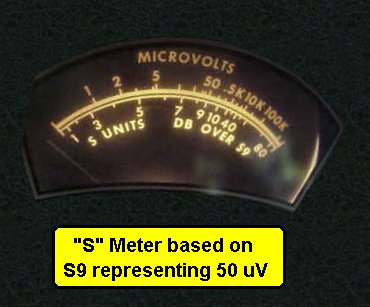

An "S" meter is fitted to some radio's (Communication Receivers) to allow the user to determine the signal strength of the transmission being heard. But What does this all mean?
As a guide; S9 on the S meter scale is reckoned to be equal to a potential of 50 uV signal voltage at the receivers aerial input. Also each "S" point is said to represent a 6 db change (up or down). A 6 db change coincidentally represents a doubling (or halving) of a voltage before/after the aforesaid change. Recalling the well known textbook formula:

Therefore the relationship of "S" meter reading to input signal voltage obeys the law

That is; because of the signal voltage doubling for each increase in "S" point the signal voltage is directly proportional to the base 2 raised to an exponent being the "S" number. To bring this into some perspective:
If 50 uV represents S9, then substituting in the above formula

To obtain (say) the signal voltage corresponding to S4 we can substitute in the above formula

Constructing a table of values based on the above we get:
| "S" reading | Voltage at RX input |
|---|---|
| 9 | 50 uV |
| 8 | 25 uV |
| 7 | 12.5 uV |
| 6 | 6.25 uV |
| 5 | 3.125 uV |
| 4 | 1.5625 uV |
| 3 | 0.781 uV |
| 2 | 0.39 uV |
| 1 | 0.195 uV |
Therefore: as you can see, each change in "S" point represents a doubling (or halving) of its immediate predecessor, all referenced to S9 being 50 uV (Some archaic texts suggest S9 as being 100uV), but the principle is still the same. Simple really !


If you have any questions related to this project then please refer them to the author Frank V. Hughes.